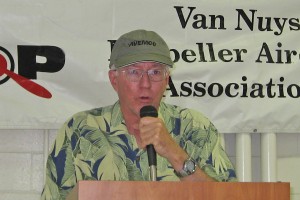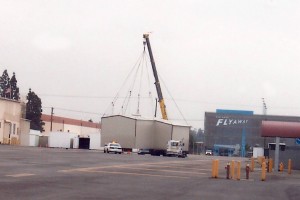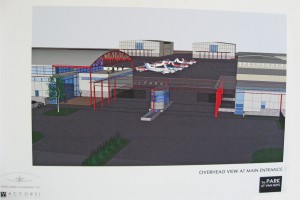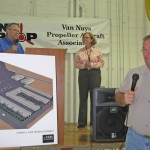
With the ghosts of the past lingering over the old abandoned Van Nuys Air National Guard base, the VNY Propeller Aircraft Association/VNY Airport Association presented the base reincarnation plan for a modern general aviation Prop Park at a joint meeting.
By Harlis Brend
The Van Nuys Propeller Aircraft Association and the Van Nuys Airport Association held their annual joint dinner meeting on May 28 at the new Air Operations, Air Support and Helicopter Maintenance Facility, Fire Station 114, in the shadow of a deteriorating relic, the old VNY control tower.
In his opening remarks, Elliot Sanders, VNY Prop Association president, stated that the tenant association, Van Nuys Airport Association, is dedicated to promoting aviation activities and helping the members of that association operate successfully at Van Nuys. The meeting’s co-host, VNY Prop Association, is dedicated to the conservation and preservation of general aviation and propeller aircraft.
Sanders summarized the ongoing activities related to developing the Propeller Park at Van Nuys Airport. More than seven years ago, VNY was in the midst of a struggle to complete a master plan that would satisfy all of the various interested parties—aircraft owners, tenants and home owners. The costs associated with running a leasehold were growing, larger aircraft were posturing for more space, small prop aircraft owners were complaining about the airport possibly forcing them off the field, and a list of other issues were on the table as well. Tenants at or near the end of their leases wanted to develop, leading to conflicts. The master plan, Alternative J, was accepted and is now in place; leaseholders who have wanted to develop for years are beginning to do so.
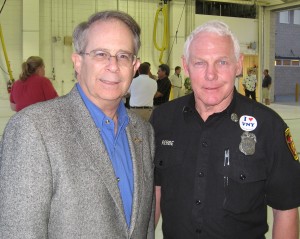
Elliot Sanders (left), VNY Propeller Aircraft Association president, and Capt. Robert Rebbe helped get the event organized at VNY Fire Station 114.
Los Angeles World Airports began the process of receiving public input for the VNY master plan in March 1992. Los Angeles’ mayor signed the master plan in February 2006. The long-term planning document, consisting of a series of goals, objectives and policies, will protect the environment and guide land use at VNY, a Southern California general aviation center, for the next 20 years.
Sanders further stated that as part of the master plan, VNYPROP and everyone involved in Alternative J fought for and received the promise of a Prop Park here at VNY. The park is envisioned as a place that would shelter, maintain and promote aircraft that provide the training for future pilots of the larger aircraft that many of the FBOs service.
“Without the little planes, we can’t fly the big planes,” said Sanders. “LAWA began asking about a Prop Park. We talked to them and they created a ‘request for proposal,’ which was 286 pages long.”
Selena Birk, VNY manager, presented some of the RFP details and discussed the process. Airport management did outreach, talking to the Propeller Association, the Hangar Association and individual aircraft owners about what the airport needed to protect the interests of smaller aircraft. The consensus was that several things had to happen along the way, such as removing some of the non-aviation uses on the airport, including the automobile storage lot for dealers. Some of the key issues that were in the RFP required the winning bidder to design, finance, construct, market and operate a high quality, self-sufficient facility for the propeller aircraft community.
Birk stated that a list of features and services was specifically designed and created because of the outreach and comments the airport received. Rated highly in facilities desired were a self-service gas refueling station, an oil recycling and dumping station, on-site wash rack, tie-down area and space for related companies and services such as flight schools, avionics and maintenance services.
According to Birk, in early 2007, VNY received two proposals. Neither one met some of the administrative requirements, so the airport rejected both. After releasing the RFP again, it received four impressive proposals.
The Prop Park will be just more than 30 acres on the west side of the airport between Balboa Boulevard and Bull Creek. Only fixed wing propeller aircraft of less the 12,500-pound gross takeoff weight and former military aircraft built prior to 1950 will be allowed in the area. The term of the Prop Park lease is to be between 10 and 30 years.
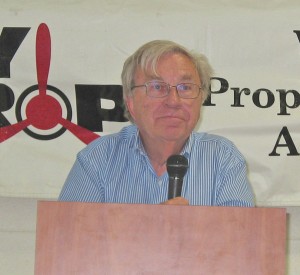
Harold Lee, Van Nuys Airport Association president, reported on the business and activities of the organization.
Preliminary work has already begun. Moving day has arrived for 60 to 65 hangars being relocated to a temporary site along Woodley Avenue, across from the VNY Flyaway terminal and onto the old Air Guard ramp. When the Prop Park is finished, these hangars will be moved to their permanent locations in the park.
The next steps include the abatement (removing asbestos) and demolishing of the old Air Guard buildings. The negotiations on the lease will be completed and approved by the board by about the time the demolition is completed and the development construction will begin. The entire project is expected to span 30 months; demolition will take 12 months, and construction will take another 18 months.
The chosen developer for the project is Steve Argubright, owner of Argubright Construction Inc. and Argubright Steel Structures. Argubright Construction is a licensed general contractor that’s been in the business of designing and building aviation hangars and projects for more than 20 years. The Argubright companies have the capability to take the project from design, manufacturing, site preparation and construction. Argubright will also provide ongoing management for the term of the lease. During the last five years, Argubright’s companies have developed more than 500,000 square feet of hangar space at projects in California, Nevada, Arizona, Maryland and Colorado.
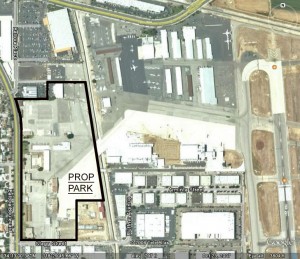
The Prop Park will be located in the northwest corner of the airport, where the Air National Guard base was located at the west end of Taxiway A2.
“The winning proposal is going to impact the airport in many ways for many years to come. You’ve heard what it should contain; now you’ll hear what it will contain,” stated Sanders while introducing Argubright.
“This proposal required that the first step to having affordable ‘housing’ on Van Nuys Airport was going to be for LAWA to have rents that were comparable with all the other airports,” Argubright said. “The established rates are cheaper than Whitman Airport and about comparable with Fullerton, Brackett or Fox. Given the cost of construction at VNY, these hangars should cost no more than any other hangar in the area.”
Argubright’s goal is for the cost to be somewhere around 50 cents per square foot for the smaller hangars and up to 90 cents per square foot for the larger ones (examples: new 42 x 35 foot rectangular hanger, approximately $750 per month; relocated T-hangars, approximately $200 per month).
Argubright described the park design as an airport onto itself, based on neighborhood concepts. People will be able to access their hangars from their own parking lot, gated community or smaller street parking areas. This limits the number of vehicles that will be within the airport.
Argubright considers the hangars to be normal hangars, no different from other airports. The amenities for all hangars will include three-phase electrical power, compressed air, computer lines and security systems. The larger hangars (50 feet) will have individual bathrooms. About 40 hangars will have a small, attached office. Flight planning rooms and areas for FBOs and other businesses that want to relocate will also be included.
“Within the park, you’ll probably see aviation differently than you’ve seen before,” stated Argubright. “The high level of aircraft activity will make it profitable for the business to be there. It may be like the old days.”
The terminal building will be approximately 30,000 square feet, and designed to be an upscale FBO, with a restaurant and rental car kiosk—everything you would see in a normal jet center will be at the Prop Park. The Park will have 50 tie-down spaces, 300 plus rectangular hangars, and provision for transient aircraft. No new T-hangars, though—only those that were temporarily relocated will be allowed. The street entrance to the Prop Park from Balboa Blvd. will be located at the same place as the original Air National Guard Base entrance.
Following the presentation was a 30-minute question and answer session. Attendees expressed concern about the eligibility for relocation of qualified owner-occupied hangers; Birk discussed a handout (RFP, Part I – General Information, Section H. Relocation of Qualified Displaced Hangars). Some areas of the airport won’t be affected by the relocation: the southwest and northeast corners, the west side between the Condor Squadron and the tower.
“The airport asked VNYPROP and the Hangar Association to sit on committees,” Sanders said as he wrapped up the meeting. “We did. We proposed the ingredients of the RFP that you heard today, and this is the result. We’re very proud of our efforts.”
“This is a good joint effort,” he continued. “LAWA is literally going to be under a microscope, as are the airport and the developer for this project. The entire country’s general aviation system, including AOPA and EAA, is watching. They want to see how this works. We fought hard for Alternative J. We have a master plan that allows for aircraft of a specific size for general aviation; there’s no reversion to turbines. The homeowners are frightened. ‘What happens if they don’t get enough props?’ That isn’t going to be a problem. This park will probably be sold out before it gets built.”
The VNY Prop Park area has a long history of use, going back to 1942 when the 4th Air Force acquired Metropolitan (Van Nuys) Airport. Following WWII, the 146th Fighter Wing flew P-51D Mustangs and later F-86 Sabre jets, from the Air National Guard Base. Also stationed at the base were C-97 Stratofreighter and C-130 transports. On April 30, 1990, the Van Nuys ANG Base lowered the flag for the last time during a special closing ceremony.
The Van Nuys Propeller Aircraft Association will use its website to keep people informed of the progress and events associated with the project. For more information, visit [http://www.vnyprop.org].
- L to R: Elliot Sanders, Selena Birk and Steve Argubright answer questions about the VNY Prop Park development project.
- A Prop Park artist concept depicts the overall view from the southwest.












